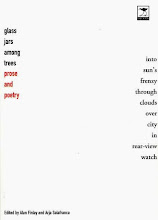Author interview and review: Damon Galgut's In a Strange Room, Penguin 2010
A man goes on a journey in these three inter-linked novellas set across time. The man's name is Damon. He observes, meets another, grows older, is touched and changed by the experiences. He watches the world, the world in turn watches him. Yet, who is Damon? On first being introduced to the narrator and also participant of these three pieces, there's a jolt. Damon the author, the centre point of the stories? The author isn't going to say.
What Damon Galgut is doing in this book amounts to play. Between the layers of seriousness, there's an artful play at work. Galgut is asking questions, challenging our preconceived notions of fiction. It's a book which keeps you, as reader, perennially on your toes, and yet supremely interested, too, in the events that are unfolding within these sparsely, almost dryly written pages.
This is a story of memory, according to Galgut, but this is also an examination of the nature of travel - and how we change and evolve as we leave what's familiar for the unfamiliar, even if, like Damon, we are not natural travellers. "The truth is that he is not a traveller by nature, it is a state that has been forced on him by circumstance. He spends most of his time on the move in a state of acute anxiety? he's constantly afraid of dying."
Galgut summons up the story of a journey: "A large part of travelling consists purely in waiting, with all the attendant ennui and depression. Memories come back of other places he has written in, departure halls of airports, bus-stations, lonely kerbsides in the heat and in all of them there is an identical strain of melancholy summed up in a few transitory details. A paper bag blowing in the wind. The mark of a dirty shoe on a tile?"
What follows is a short description of plot, because plot is not central to this series of novellas.
In the first novella, The Follower, Damon meets a man, Reiner, while travelling in Greece. When Reiner visits him in South Africa the two undertake a disastrous journey to the isolated mountain kingdom of Lesotho. It's made disastrous by Damon's passivity, and a sense of threat emanating from Reiner.
In the second novella, The Lover, the same passivity follows Damon as he travels through Africa years after his journey through Greece. While in Zimbabwe he meets a group of European travellers, and keeps meeting up with them, despite trying to go his own way. One of the travellers, Jerome, exerts a strange pull and Damon will travel to Switzerland, but the end is concluded, again, by Damon's nature.
However, in The Guardian, Damon is propelled into action in turn by the wild actions of his friend Anna. They have travelled to India together, in some sort of hope that the wildly unstable Anna will be calmed and soothed by being away. It reads like a high-action thriller as Damon's passivity is thrown off. This was a deeply compelling piece, made unbearably poignant by what happens to Anna and Damon.
The writing is tight and spare; landscape forms a backbone to all three stories, suggested rather than painted in primary colours. The real surprise is when Galgut chooses to invert the traditional method of telling a story, first person morphs into third and back again. At first, you're jolted by the device, then it becomes part of the telling, and is a surprisingly effective device and not at all disruptive to the reading. Here's an example: "What is he looking for, he himself doesn't know. At this remove, his thoughts are lost to me now, and yet I can explain him better than my present self, he is buried under my skin."
Intrigued by this device, I ask Galgut what he means by it. He writes in an e-interview from Italy: "The real subject of this book is memory. In the writing, I have tried to capture something of the quality of the way memory works. That's the reason for the switch - in memory one is sometimes an 'I', back in the moment being recalled; then at other times a 'he' or 'she', a stranger observed from outside. And sometimes also a 'you', somebody one can address over the intervening time. It sounds cumbersome, but I hope it reads effortlessly, because it's something we all do unconsciously in our heads the whole time. Of course, memory is another sort of story we tell ourselves, which is why the book is written as fiction."
We're on to the territory between fact and fiction here. I'm going to ask the inevitable question of the line between autobiography and fiction in a writer's work.
I recall the lines in the second novella, The Lover, when Damon is recalling the Swiss Jerome: "?Because in every story of obsession there is only one character, only one plot. I am writing about myself alone, it's all I know and for this reason I have always failed in every love, which is to say at the very heart of my life."
Galgut answers: "All writers are drawing on their own lives to some extent, though, of course, some experiences sit closer to home than others, as I hope this book makes clear. I think the borders between fiction and non-fiction, imagination and 'truth', are extremely porous. Sometimes there's no distinction at all."
The line dissolves: in the second novella, Galgut writes that, "a journey is a gesture inscribed in space, it vanishes even as it's made? things happen once only and are never repeated, never return. Except in memory."
And memory remains - through all its twists and turns, what is remembered one way one day is remembered a completely different way in another light, or in another emotion. Galgut's In a Strange Room offers a remarkable encounter with memory and meaning of travel and the games we unwittingly play as we attempt to make sense of the knotted strands of our journeys, both external and deep into our own selves.In a Strange Room was shortlisted for the 2010 MAN Booker Prize.
The winner, announced on Tuesday, was London author Howard Jacobson, for his novel The Finkler Question.
Published October 14 2010 The Star Tonight and in Pretoria News
Tuesday, January 18, 2011
Memories of the way we were . . .
Labels:
Arja Salafranca,
author interviews,
Book reviews,
Damon Galgut
Subscribe to:
Post Comments (Atom)





.jpg)

No comments:
Post a Comment